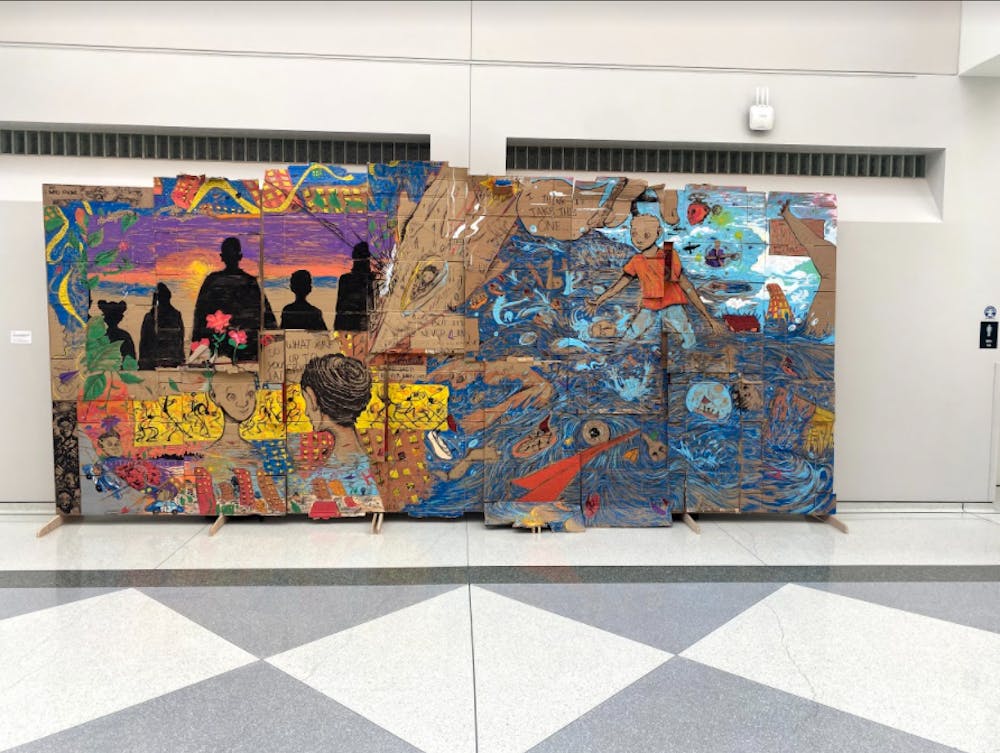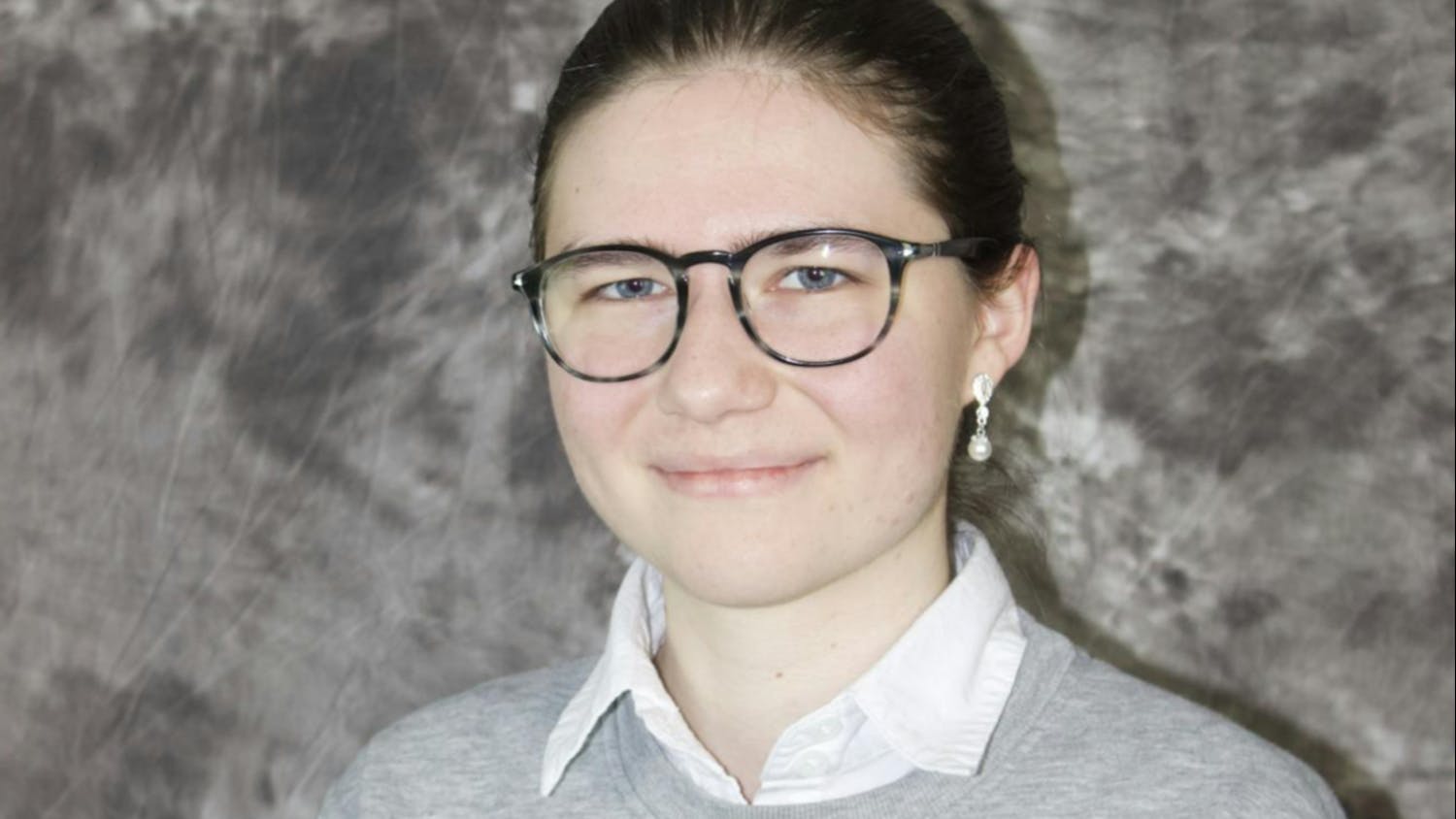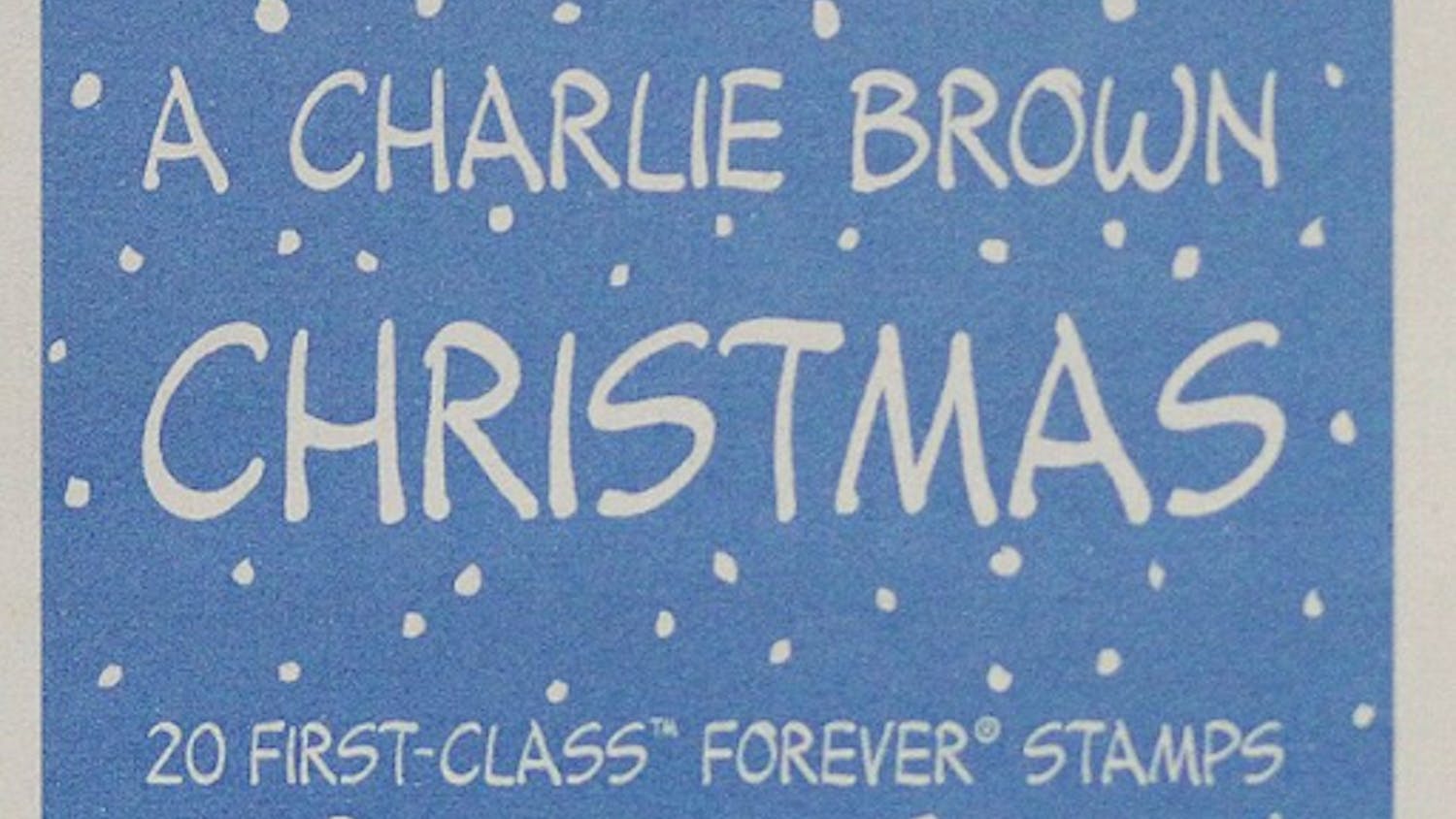Not since the beginning of COVID-19, has creativity echoed so loudly through the halls of UB’s Center for the Arts. On Thursday, the CFA opened its doors to four new exhibits collectively referred to as “Fall into Art.”
Featuring two large murals and several smaller displays, the CFA Atrium’s bleach white walls are plastered with an explosion of colors for “The City Talks to Itself,” an exhibition honoring Buffalo’s rich history of murals, graffiti and other forms of street art and their relationship to social justice.
Curated by Bronwyn Keenan, director of the Arts Collaboratory, the full-sized murals and several smaller displays take up large portions of the wall, telling stories of life on the streets of Buffalo.
“Street art is the city talking to itself,” Keenan said. “It’s long been a voice for the voiceless who’ve used the city’s walls to call out for justice. It’s where communities paint tributes to loved ones and celebrate heroes.”
The left wall of the Atrium houses “An attempt at Illustrating the ineffable while walking to East 163rd St in the Bronx,” a cardboard mural by Tayron Lopez, the Arts Collaboratory’s 2021-22 artist-in-residence. The piece portrays an array of sights seen and conversations heard while traversing 163rd Street. The mural is filled with drawings of people, floods and flying heads side by side with much of the overheard dialogue, containing phrases like “I think I’ll take this one…” and “So what are you up to later!”
Ma-Nya Champagne, a junior photography major, felt the murals were highly realistic and respectful representations of NYC.
“‘The City Talks to Itself’ is a great name for these overall pieces because as I walk through the gallery, I feel like I’m back in Brooklyn,” Champagne said.
In the Lower Gallery, attendees can explore works by the 2023 MFA candidates with the appropriately titled, “Incoming.”
This exhibit has been open since Aug. 31, but a reception was held during “Fall Into Art” for the candidates to formally introduce themselves.
Featuring an exciting array of art styles from UB’s next generation of artists, Mark Snyder, art resource manager for the Department of Art, says the exhibit acts as an entry point for the incoming class into the larger world of art.
“It’s our way of introducing the incoming class to, basically, the city of Buffalo, and the art community in general,” Snyder said. “Here, we try to work very closely with the galleries and museums of the City of Buffalo and this is our way of sort of showing the next crop of MFA is coming into the program.”
Taylor Robers, an MFA candidate from Minnesota majoring in studio arts, drew “Summer Home,” an oil on basswood painting of a bluebird nest representing multiple connections to her life back home.
“I did a bluebird survey in Minnesota as a volunteer thing and this was the only bluebird nest from the entire season of the survey,” Robers said. “So, it was kind of a tribute to that and then kind of leaving my nest at home and moving to a completely new place.”
Another prominent piece of the exhibit was an archival pigment print titled “Nowhere Town,” by MFA candidate Alex Cassetti, which showcases a black and white photo of a barn.
“They all have their own personal pieces, sort of, exhibiting their own artistic direction and style,” Snyder explained. “So, it’s a way of introducing our grad [students] to the faculty who have maybe not yet gotten to know them because we're only on the second week of classes.”
Seth Woods, a cellist and UB Center for Diversity and Inclusion visiting professor), says he’s a fan of the variety of mediums displayed and felt it was a great opening event for the new class.
“It’s been really great to get an idea of what the MFA students have been up to. Downstairs the exhibition is quite exciting,” Woods said. “A lot of risk taking with some of the smaller [and] larger scale works on mixed media-based, film-based and jewelry-based [mediums], so it’s a wide variety. I’m excited to see what they do [in the future].”
Revealing a lesser-known piece of UB history, Liz Park, curator of exhibitions for UB’s art galleries, curated the historical “F: Reconstituting Tolstoy College” exhibition displayed in the second floor gallery,, which walks attendees through the story of Tolstoy College, UB’s anarchist college (one of six experimental colleges ran by UB), through displays of furniture and archival documents from the school’s existence, from 1969-85.
Representing unconventionality in its purest form, the furniture displayed emphasizes the anarchist ideals of making do with what you have, like a table with saw horses for legs or seatless chairs paired with a make-shift table wooden-plank table.
“Anarchism was a way of exploring how a group of people can work together, honestly [and] frankly, and determine their own course of educational pursuit,” Park said. “So, this exhibition is an attempt to read a history that is hard to capture.”

Scattered across the exhibit are a variety of documents detailing the college’s ideals, policies and class syllabi. Two of the most interesting documents are a professor’s policy on giving a fixed number of A’s and Spectrum articles written by Tolstoy college member Charles Haney.
“For him [Haney] it was really important that his writing and his politics and his thoughts be shared with the students,” Park said. “Charles Haney was somebody who was instrumental in the college.”
While onlookers absorb themselves in the CFA’s variety of works, no exhibit stands out as much as artist Heather Hart’s “Afrotecture (Re)Collection,” wowing attendees with a recreation of the Lorraine Motel balcony in Memphis, TN where Martin Luther King Jr. was assassinated in April 1968.
Recreating such a historic place is no easy task, however, Hart has become accustomed to creating these types of spacious installations, growing up with her father, a carpenter.
“She has had experience from a very early age witnessing how lumber can demarcate space and how it becomes a container for social relations” Park said.
Attendees take turns walking up the interactive piece’s solid-gray staircase where the sound of footsteps become lost in the whispers of awe-struck admirers, a breeze of loneliness creeping in as they make it to the top, where the whispers become drowned out by the cold atmosphere of one of the darkest days in civil rights in the U.S.
Some visitors appreciated the outside-the-box concept Hart used for the exhibition. Swedin Peart, a senior speech and hearing sciences major, enjoyed the “glassy floor’s” eeriness.
“I thought it was very different. It wasn’t the…regular gallery that you would just walk into and see paintings or regular artwork,” Peart said. “It had more of a storyline, that was cool.”
For those who missed out on these openings, “F: Reconstituting Tolstoy College” will run until March 12, “Afrotecture (Re)Collection” will run until May 21, “The City Talks to Itself” until May 27 and “Incoming” until Oct. 1. Admission is free.
Alex Falter is the senior arts editor and can be reached at alex.falter@ubspectrum.com

Alex Falter is a senior arts editor at The Spectrum.





